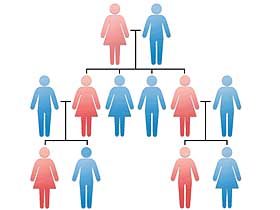In the period during which Darwin developed the theory of evolution, the question of how living things transmitted their characteristics to later generations was unknown. Therefore, primitive conjectures such as traits being transmitted by way of the blood were widely accepted. This uncertainty about the mechanisms of heredity led Darwin to predicate his theory on a range of completely erroneous assumptions.
He pointed to natural selection as the basis of the evolutionary mechanism. Yet if beneficial attributes were chosen by means of natural selection (the survival of the fittest"), how could they be transmitted from one generation to another? At this point, Darwin embraced the thesis, which Lamarck had proposed, of "the transmission of acquired characteristics."
However, Lamarck's thesis was refuted when the laws of inheritance discovered by the Austrian botanist and also a priest Gregor Mendel. This meant that beneficial traits could not be passed along. Genetic laws demonstrated that acquired features were not handed on, and that inheritance took place according to immutable rules-which by implication supported the idea of the immutability of species.
The laws of inheritance, determined by Gregor Mendel after lengthy experiments and observations, were published in 1865. However, these laws attracted the interest of the scientific world only towards the end of the century. Scientists accepted the validity of these laws in the early 20th century. This represented a serious impasse for Darwin's theory, which he had based on Lamarck's "beneficial traits."
For that reason, scientific adherents of Darwinism in the first quarter of the 20th century sought to develop a new model of evolution. Thus neo-Darwinism was born. (See The Neo-Darwinism Comedy.)


